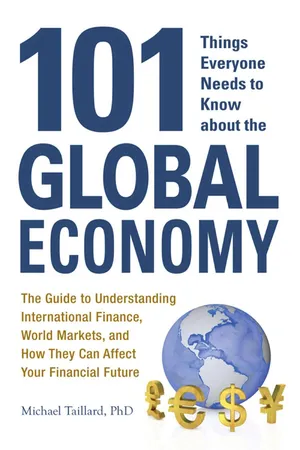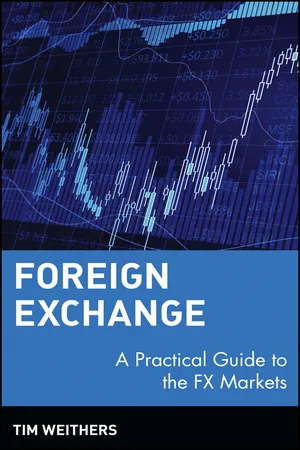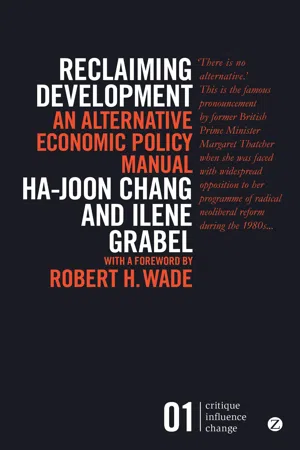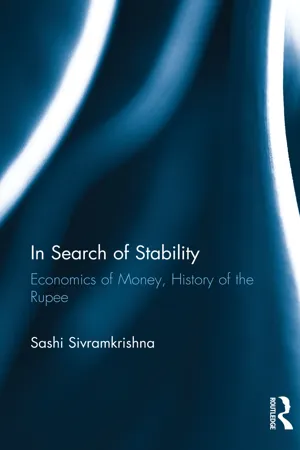Economics
Fixed Exchange Rate
A fixed exchange rate is a system in which a country's currency is pegged to the value of another currency or a basket of currencies. This means that the exchange rate is set and maintained by the government or central bank, and it does not fluctuate based on market forces. Fixed exchange rates can provide stability and predictability for international trade and investment.
Written by Perlego with AI-assistance
Related key terms
7 Key excerpts on "Fixed Exchange Rate"
- eBook - ePub
- W. Charles Sawyer, Richard L. Sprinkle(Authors)
- 2020(Publication Date)
- Routledge(Publisher)
One of the reasons why we study Fixed Exchange Rates is historical. Until the early 1970s, Fixed Exchange Rates were the norm for all countries. For example, under a gold standard, each country’s domestic currency was defined in terms of the amount of gold it could buy. In addition, each country’s central bank was willing to buy or sell unlimited quantities of gold at the stated price. Since all currencies were defined in terms of gold, this maintained a Fixed Exchange Rate between the various national currencies. In this case, Fixed Exchange Rates were a natural part of a monetary policy based on gold. When the gold-standard monetary system broke up in the late 1920s, it was replaced by a system of Fixed Exchange Rates known as the Bretton Woods system. Under Bretton Woods, most exchange rates were fixed from 1946 to the early 1970s. In order to understand the history of monetary systems, it is useful to have a basic understanding of how Fixed Exchange Rate systems work.The second reason we study Fixed Exchange Rates is that a number of countries worldwide fix (peg) the value of their domestic currency to that of another country.1 In addition, there are a number of countries in the EU that have taken a Fixed Exchange Rate system one step further and have created a common currency—the euro. A common currency in a large country such as the U.S. is just a Fixed Exchange Rate system applied to all states within the U.S. By studying how Fixed Exchange Rates work, we can learn a great deal about how the economies of many countries work and in the process learn something about how the various regions within a large economy such as the U.S. react to changes in the national economy.INCONVERTIBLE CURRENCIESThe first method that a country can use to fix the value of its currency in the foreign exchange market involves making its currency inconvertible. An inconvertible currency is a currency that cannot be freely traded for another country’s currency by domestic consumers and businesses. The common term used to describe this system is exchange controls - eBook - ePub
International Finance
For Non-Financial Managers
- Dora Hancock(Author)
- 2018(Publication Date)
- Kogan Page(Publisher)
Floating systems may be managed, with governments interfering in markets, usually in an attempt to stabilize the exchange rate rather than achieving a target rate. Or they may be independent, called freely floating, where markets are left to determine the exchange rate. This is achieved by the law of supply and demand. That is, if people want to buy a currency, the demand for it goes up and the currency appreciates in value, while if they want to sell it, supply goes up and the currency depreciates in value.Managed system
There are a number of other systems which are designed to manage the exchange rate system. The IMF report found that there was a move towards more stable exchange rate systems, particularly the use of soft pegs.More countries are considering other factors as well as exchange rates when determining their monetary policy, whereas in the past the focus was more on exchange rates. Generally, there was a move towards greater transparency and increased financial liberalization, particularly of capital flows. We will look very briefly at each of these systems but our focus will be on the broader fixed and floating systems.Fixed rate exchange rate systems
These are also called pegged rate systems. They may take the form of a hard peg, where the government cannot change the exchange rate policy, or a soft peg, which is under the direct control of a government or its agents.In a fixed rate exchange rate or conventional peg system the government of a country pegs or fixes its currency against the currency of another country, often a major currency, particularly the US dollar, which is the world’s major reserve currency. Alternatively, the peg may be against a basket of currencies.Once the exchange rate has been fixed, it will be announced and the government is committed to exchanging currency at the published rate. The government will need to take any necessary action to maintain the exchange rate. For example, if the currency is under pressure to devalue against the pegged currency, a government might buy its own currency in foreign markets to increase demand for its own currency. If this is done, the government will need to use its foreign currency reserves to buy its own currency. Equally, if the currency is at risk of appreciating, the government might wish to sell its own currency in foreign exchange markets in order to increase the supply of its own currency. In practice, this is unlikely to be a successful strategy so the government will have to resort to increasing or reducing the demand to hold its own currency by increasing or decreasing interest rates. - eBook - ePub
101 Things Everyone Needs to Know about the Global Economy
The Guide to Understanding International Finance, World Markets, and How They Can Affect Your Financial Future
- Michael Taillard(Author)
- 2012(Publication Date)
- Adams Media(Publisher)
While the underlying nature of currency has not changed since its original inception, it’s now far more sophisticated. In the modern era there are many types of currency, with differences ranging from the amount of goods that can be purchased per unit to how much of one currency can be purchased with another. The valuations, exchanges, and methods of managing currency have all become very involved but not at all difficult to understand. Learning how currency works will very much improve your ability to manage your money. Particularly in the international environment, which includes some additional complexities that provide the opportunity to benefit or the risk of harm, your financial security depends on how well you understand the nature of currency transactions.26. Fixed Exchange RateS
An exchange rate is how much of one currency you can buy with another. For example, at the time of this writing, one U.S. dollar will buy exactly 0.7641 euros (which would be written as USD1 = EUR0.7641). The inverse value is EUR1 = USD1.3087. One unit of a particular currency will purchase a number of units (or a fraction of a unit) of some other currency.There are two primary types of exchange rates. The easiest of these to understand is the Fixed Exchange Rate, also called a pegged exchange rate. A Fixed Exchange Rate is one in which the value of one currency is exchanged at exactly the same rate as another currency, no matter how this other currency fluctuates. For instance, if the Mexican peso is fixed to the U.S. dollar at a one-to-one rate (where MXN1 = USD1), then no matter how the U.S. dollar changes value compared to any other currency in the world, the exchange rate between the dollar and the peso will remain the same. The implication of this is that if the exchange rate of the U.S. dollar to the British pound goes up 10 percent, then the exchange rate between the Mexican peso and the British pound will also go up by 10 percent because of the rate fix between the dollar and the peso. - eBook - ePub
Foreign Exchange
A Practical Guide to the FX Markets
- Tim Weithers(Author)
- 2011(Publication Date)
- Wiley(Publisher)
What are the ultimate negative implications of fixing an exchange rate (or maintaining the price of foreign exchange within a band)? There are two primary issues. First, as experienced by Norman Lamont, Chancellor of the Exchequer, and the Bank of England in 1992, while attempting to maintain the GBP exchange rate within its tight ERM range, and in the face of mounting speculation (or a “speculative attack” as the media seems to like to call it), the central banking authorities could run out of the foreign exchange reserves necessary to preserve the value of their currency in the market. When that occurs (especially without the collaborative support of other central banks), the fixed rate of exchange will presumably collapse (as it did for the Pound on Black Wednesday). Second, by formally linking one country’s currency to another country’s currency at a fixed rate of exchange, disparities in monetary policy will invariably tend to cause imbalances that will ultimately culminate in a breakdown of that peg. For example, a country with a monetary policy that induces a relatively rapid growth in their money supply (relative to a neighboring country), under a Fixed Exchange Rate regime, can “export” their inflation to their neighbor. The transmission mechanism is through increased spending on the part of the country with the expanding money supply (some of which will be directed to imports). As these growing funds find their way into the other country, there will be a natural pressure for the “inflated” currency to depreciate, but the central banks and monetary authorities will have to maintain the Fixed Exchange Rate (by buying up the expanding currency).The result will be ever mounting reserves of the relatively faster growing currency in the coffers of the monetary authorities, and the “forced” purchase of that currency on the part of the less expansionist country. In effect, their money supply must be “grown” to maintain the FX peg and will have the impact of inducing inflation in a country that would otherwise have had less.This leads to the notions of “open economies” (as opposed to “closed economies”) and “openness,” which are intended to indicate the relative importance of the international trade sector for an economy and the exposure for such an economy to policy impacts or other “shocks” (monetary or real) abroad.A current, real world example of a “pegged” exchange rate and the imbalances that result can be seen in the case of international trade between the United States and China. The United States has been running record trade imbalances (to be more precise, “trade deficits,” which implies that the United States is importing more goods and services than they are exporting; this is sometimes called a “current account” deficit). What this really means is that the United States is exporting Dollars in exchange for products from around the world (and increasingly from China). In September 2005, the monthly trade deficit was an unprecedented USD 66.1 billion; for the first nine months of 2005, the cumulative trade deficit was USD 503 billion. The natural implication of all this is that the USD should weaken, but China has maintained a (somewhat) pegged exchange rate, meaning that they have had to “absorb” those Dollars. If China were to sell these Dollars on the world market, the value of the Dollar would fall, Chinese products would look more expensive to American consumers, U.S. products would look cheaper to the rest of the world, and there would be an automatic force at work (Adam Smith’s “invisible hand” operating on a global scale) to reverse those imbalances. As it is, China has actively kept the Renminbi weak (thereby encouraging Chinese exports and real economic growth in China). The way in which the Central Bank of China has kept the Renminbi weak has been through their willingness to absorb the U.S. Dollars they have received via international trade. What has China done with the Dollars they have accumulated? - eBook - ePub
Reclaiming Development
An Alternative Economic Policy Manual
- Ha-Joon Chang, Ilene Grabel(Authors)
- 2014(Publication Date)
- Zed Books(Publisher)
In some pegged exchange rate systems, the range within which the currency can fluctuate is informal and/or is unknown to the public. Consistent with our support for accountability and transparency, we suggest that currency pegs should be a matter of public knowledge. We also maintain that there are good economic reasons to create mechanisms whereby currency pegs can be modestly adjusted as economic circumstances warrant (e.g. as inflation rates change).In his proposal for a system of adjustable pegged exchange rates, Grieve Smith (2002 ) argues that central banks should review currency pegs at frequent intervals (say, monthly) so that small adjustments in rates can be initiated through central bank intervention. He also argues that adjustments to exchange rate pegs should be automatic and expeditious. Frequent, modest and automatic adjustments can minimize the scope for destabilizing speculation against a currency peg. In the absence of this type of adjustment framework, speculative pressures can build because of uncertainty about the timing and extent of intervention in currency markets.To summarize: support for adjustable pegged exchange rate regimes is provided by the historical achievements of pegged rates in developing and industrialized countries and by the demonstrated economic and social costs of currency volatility in developing countries.7 As discussed above, the sustainability of any pegged exchange rate system depends on the presence of capital controls (see Chapter 9 ).11.2 Central Banking and Monetary PolicyTerminologyCentral banks are charged with carrying out a country’s monetary policy. Monetary policy refers to government actions that influence the money supply and market interest rates. Central banks use a variety of tools to achieve these objectives, such as purchasing or selling government bonds on the open market, or changing the rate of interest that it charges the individual banks to which it lends. In so far as interest rates represent the cost of credit, monetary policy critically influences the level of investment and expenditure, and thereby affects the price level and the rate of economic growth. - eBook - ePub
- Javier A. Reyes, W. Charles Sawyer(Authors)
- 2019(Publication Date)
- Routledge(Publisher)
219, it would seem clear what should be happening to the exchange rate. There should be a rapid depreciation associated with falling oil prices and rising inflation. However, the country has chosen not to let this happen. Instead, there is a complicated system of Fixed Exchange Rates, with the central bank rationing the scarce foreign exchange to different sectors of the economy at rates far below the equilibrium exchange rate, while the nominal exchange rate is quietly equilibrating. Over the past ten years, the real exchange rate has appreciated in terms of an index number from around 80 to 320. The rate of appreciation is now almost vertical. Given that the inflation rate in the country is now close to 70 percent and expected to rise further, the appreciation of the real exchange rate is perfectly understandable. This is just an extreme example of the usefulness of the concept of the real exchange rate. With high inflation and a Fixed Exchange Rate, only the real exchange rate can provide information on what the currency is worth. Managed exchange rates At the beginning of this chapter, we covered the total inflows and outflows of money into a country by studying the components of the current account. As we saw, these flows have an effect on the exchange rate. As a consequence, countries have to make decisions about how to manage the exchange rate. However, one has to be careful in defining the term “exchange rate.” Most of the time, we are referring to the nominal exchange rate posted in the market. However, the related concept of the real exchange rate is important. As shown on p. 220, the real exchange rate can change even if the nominal exchange rate does not. The real exchange rate can have an important impact on the volume of trade and on the economy overall. This makes the choice of an exchange-rate regime important. The exchange-rate regime is the system a country uses to manage the exchange rate and the foreign-exchange market - eBook - ePub
In Search of Stability
Economics of Money, History of the Rupee
- Sashi Sivramkrishna(Author)
- 2016(Publication Date)
- Routledge(Publisher)
This problem is illustrated in Figure 7.1. Here D is the domestic economy and F the foreign economy. Suppose the following rates are announced or are determined by the gold content of the currencies: C F = 10 oz. of gold and C D = 1oz. of gold. Then C F = 10C D or C F /C D = 10. Of course, there still remains an element of risk for there could be a revision in the par value of the currency. For example, the rate of currency D (C D) could be revised from (say) 1 C D = 1oz. gold to 1 C D = 0.90 oz. of gold. Now C F /C D = 11.1. This is a devaluation of C D. Imports from F would decline and so would the demand for C F. D’s exports would become more competitive and F would import more goods from D so that supply of C F increases. Now if at the exchange rate of C F /C D = 10, the demand for C F (the foreign currency) exceeds the supply of C F then without recourse to a revision in the par rate (to C F /C D = 9), the only way in which equilibrium can be restored in the foreign exchange market is through shifts in the demand and/or supply curve for C F. Figure 7.1 : Fixed Exchange Rates under the Gold Standard The exchange rate standards described above are essentially Fixed Exchange Rate regimes. They had the advantage of maintaining stability and minimizing risk from exchange rate fluctuations on trade and capital flows. However, when there was disequilibrium in the balance of payments, since exchange rates could not change in order to restore equilibrium the only alternative was for ‘quantity’ to change. In other words, the economy itself had to expand or contract to increase or reduce the volume of exports or imports; this would be reflected in Figure 7.1 as shifts in the supply of and demand for foreign exchange (C F) respectively. The ‘rules of the game’ were to ensure that these shifts happen, endogenously. An excess supply of C F implies that country D has a surplus in its balance of payments and F would have a deficit (assuming a two-country world)
Learn about this page
Index pages curate the most relevant extracts from our library of academic textbooks. They’ve been created using an in-house natural language model (NLM), each adding context and meaning to key research topics.






